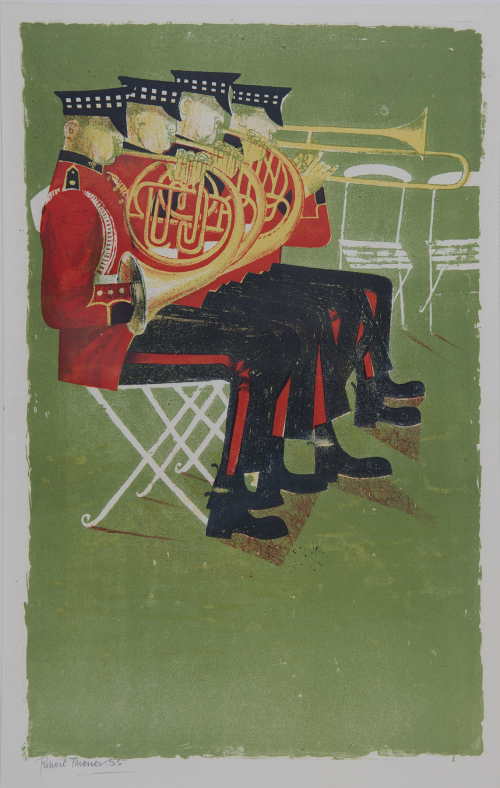
Printmaking as important as painting

Printmaking has always been regarded as playing second fiddle to painting, so as a printmaker I was interested to know how many original fine art prints are held in the MTG collection. It seems as a regional museum we are well endowed, with approximately 800 prints being held. This is thanks in part to the efforts of former director Leonard Bestall, who travelled overseas in the 1950s to collect examples of European fine and applied arts.
One print that I have admired previously in a book I own is ‘Sounding Brass’; an early lithograph by Robert Taverner, so I was excited to know that one was held in our collection.
The book ‘Robert Taverner; printmaker and illustrator’ by Emma and Richard Masonwas a gift from my sister when I visited her in East Sussex, England and admired her copy. This book has proved worth more than gold, assisting me in the printmaking classes I teach. As soon as my beginner linocut artists flick through the pages, they are inspired and excited about the medium. There is something about the textures in Taverner’s work, the composition and the colour palettes that really get the creative juices flowing. As I read his life story, I realised Taverner had held a teaching post at a particular design school during the 1950s that I attended approximately 30 years later, in Kent.
Robert Taverner was a printmaker and illustrator born in 1920 that lived for most of his life in the south of England. He was dedicated to his family first and foremost, his creative practice, and to educating the public on the difference between an original print and the reproduction print. An original print might be made as a limited edition, therefore there will be a finite number of them, not just one from which copies are made. The work that goes into creating fine art prints has often been disregarded as a process, however it can take weeks or even months to prepare each colour layer for printing, whether it’s linocut, woodcut, lithography or etching. Each block or plate is carefully crafted by hand and printed one at a time with a press, that uses pressure to transfer ink onto paper. Each colour layer is printed over the top to eventually create the image.
Taverner served in the Royal Artillery during the second world war and in June 1944 took part in the Normandy landings. While still a soldier at the end of the war he studied drawing at the College of the Rhine Army, which lead him to apply to the Hornsey College of Art in London where he focussed on lithography and took a teaching diploma. Subsequently, Taverner’s career took off as he worked as a tutor in various tertiary art institutions while exhibiting prolifically and completing commissions. Some of these included children’s books, numerous cover illustrations for magazines such as Homes and Gardens, and posters for London Transport. He became a senior fellow of the Royal Society of Painter-Printmakers in 1973 and after suffering in later life from Raynaud’s disease, Taverner passed away peacefully in 2004.
’Sounding Brass’ is a small, colour-filled lithograph that on closer inspection appears not to have been numbered as an edition. Dated as 1955, it appears in the book I own as part of a wider body of work focussed on post war Britain, images of fairgrounds, allotments and brass bands. On closer inspection it’s possible to differentiate the individual layers of colour, and the use of splatters and masking to create textures and shapes within the image. The contrasting solid line of the boots act as a focal point and are a strong component of the overall composition. It’s altogether a very charming example of Taverner’s early work.
Taverner likened the difference between oil painting and printmaking to a symphony orchestra and a string quartet. They both make beautiful sounds made up of a harmony of different instruments, but they are different. I like this analogy, and the belief that one medium is not superior or worth more in value to the other. ‘Sounding Brass’ is part of our collective history; a recording of another time, another place, and a unique process.
Published in the Hawke’s Bay Today newspaper on 1 April 2023 and written by Lisa Feyen, Online Media & Administrator at MTG Hawke’s Bay.
Image: Sounding Brass by Robert Taverner [6453], collection of Hawke’s Bay Museums Trust Ruawharo Tā-ū-Rangi
3 April 2023



